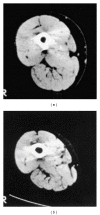Musculoskeletal disorders in chronic obstructive pulmonary disease
- PMID: 24783225
- PMCID: PMC3982416
- DOI: 10.1155/2014/965764
Musculoskeletal disorders in chronic obstructive pulmonary disease
Abstract
Chronic obstructive pulmonary disease (COPD) is a lung disease characterized by airway obstruction and inflammation but also accompanied by several extrapulmonary consequences, such as skeletal muscle weakness and osteoporosis. Skeletal muscle weakness is of major concern, since it leads to poor functional capacity, impaired health status, increased healthcare utilization, and even mortality, independently of lung function. Osteoporosis leads to fractures and is associated with increased mortality, functional decline, loss of quality of life, and need for institutionalization. Therefore, the presence of the combination of these comorbidities will have a negative impact on daily life in patients with COPD. In this review, we will focus on these two comorbidities, their prevalence in COPD, combined risk factors, and pathogenesis. We will try to prove the clustering of these comorbidities and discuss possible preventive or therapeutic strategies.
Figures





References
-
- Vestbo J, Hurd SS, Agusti AG, et al. Global strategy for the diagnosis, management, and prevention of chronic obstructive pulmonary disease: GOLD executive summary. 2013;187(4):347–365. - PubMed
-
- World Health Statistics. internet Communication, 2013.
-
- Skeletal muscle dysfunction in chronic obstructive pulmonary disease: a statement of the American Thoracic Society and European Respiratory Society. 1999;159(4):S1–S40. - PubMed
Publication types
MeSH terms
LinkOut - more resources
Full Text Sources
Other Literature Sources
Medical

